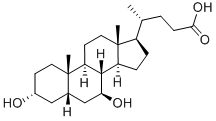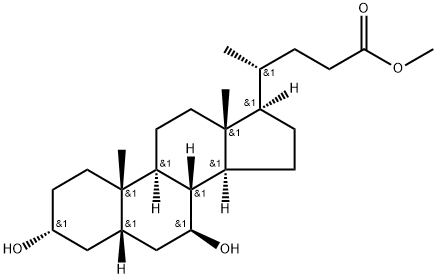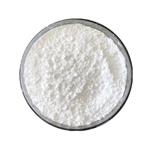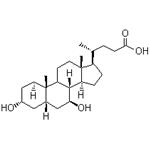Choleretic drugs
Ursodeoxycholic acid is a chemical agent of natural bile acid which is isolated from the bile of bear. It is the stereo-isomer of chenodeoxycholic acid. It has a similar litholysis effect, efficacy as chenodeoxycholic acid. However, it has a short course of treatment and a small dose. It is bound with taurine in the bile in vivo, and is a hydrophilic bile acids as well as a dissolving agent of cholesterol. It can reduce the secretion of cholesterol in the liver, lower the saturation content of cholesterol in bile, promote the secretion of bile acids, and increase the solubility of cholesterol in the bile so that cholesterol gallstones can be dissolved or prevented. Moreover, it can increase the secretion amount of bile, and have a choleretic effect by relaxing the bile duct mouth sphincter which smoothen the discharge of calculus. This product, however, cannot dissolve other types of gallstones. Ursodeoxycholic acid is useful in the treatment of cholesterol stones, hyperlipidemia, bile secretion disorders, primary biliary cirrhosis, chronic hepatitis, bile reflux gastritis and prevention of liver allograft rejection and reaction. The calculus-dissolving effect of this product is slightly weaker than the CDCA.
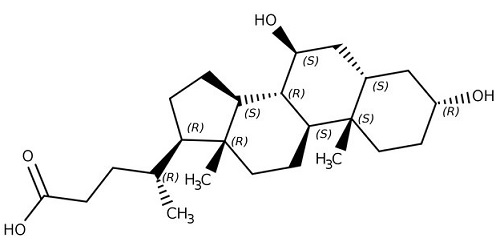
ursodeoxycholic acid structure
Pharmacological effects
Ursodeoxycholic acid, namely 3α, 7 β-dihydroxy bile acid, is the 7β-hydroxy epimer of chenodeoxycholic acid. Because of this small structural difference, the product is hydrophilic. It can reduce the activity of the rate-limiting enzyme in cholesterol synthesis in the liver--β-hydroxyl-β-methylglutaryl coenzyme A (HMG-CoA) reductase, thus inhibiting the cholesterol synthesis. It also forms a stable liquid crystalline suspension with cholesterol, and thus unsaturated the bile cholesterol, thereby promoting the separation and dissolution of cholesterol stone. This product can also inhibit the intestinal absorption of cholesterol. Ursodeoxycholic acid can also antagonize the cytotoxic effects of endogenous hydrophobic bile acids, protecting the liver cell membrane. By reducing the overexpression of the main membrane tissue compatibility antigen MHC-1, it can inhibit the production of interleukin-2,4, tumor necrosis factor and interferon α; and increasing the body's levels of interleukin-10,12; It also directly binds to the glucocorticoid receptor, playing a role in immune regulation. In addition, Ursodeoxycholic acid can also inhibit apoptosis, inhibit inflammation, scavenge free radical and have antioxidant effects. After oral administration, it is absorbed through non-ionic passive diffusion in the jejunum, and through active transport in the ileum. The effect of first-pass is large, 50% to 75% of the orally administrated dose is uptake by liver. It is mainly distributed in the liver, intestines and blood plasma, and has a 96% to 99% plasma protein binding rate. Ursodeoxycholic acid concentration in the bile exhibit dose-dependent increase; upon a dose of 20~30mg/(kg ? d), its concentration in bile is over 60%, reaching the best therapeutic effect. It binds to glycine, taurine in the liver, and is metabolized by intestinal. A small part of metabolite product is excreted from by urine, mostly by the fecal excretion. Biological half-life of oral administration is 3.5 to 5.8 days.
The above information is edited by the Chemicalbook of Dai Xiongfeng.
Drug Interactions
(1) In combination with chenodeoxycholic acid, the effect of promoting cholesterol level and de-saturation in bile were more than single drugs. The effect is also greater than that of the sum of the two drugs.
(2) This product is not suitable taken together with cholestyramine or antacids containing aluminum hydroxide for not affecting the absorption.
(3) Oral contraceptives may affect the efficacy of the product.
Side effects
Ursodeoxycholic acid has a small side effects than chenodeoxycholic acid. It generally doesn’t cause diarrhea. Occasional occurrence of constipation, allergies, headaches, dizziness, pancreatitis, and tachycardia.
Precautions
(1) For elderly patients, apply with caution.
(2) Long-term use can increase the number of peripheral platelet.
(3) If biliary colic occurs recurrently during the treatment of cholesterol gallstones and the symptoms are not alleviated or even become worse or clear stones calcification happen, stop the treatment and apply surgery.
(4) This product cannot used to dissolve bile pigment stones, mixed stones and stones cannot be penetrated by X-ray.
(5) Check liver function regularly during the treatment.
Chemical Properties
White powder; odorless, bitter taste. M.p.: 200-204 °C. Highly soluble in ethanol and glacial acetic acid, soluble in sodium hydroxide solution but insoluble in chloroform. UDCA is the isomer of CDCA, which has stronger stone-dissolving effect than CDCA and cause no diarrhea and liver toxicity. UDCA can reduce the absorption of cholesterol, and can reduce the synthesis of cholesterol and the level of cholesterol in bile. In addition, UDCA can also reduce the concanavalin A-binding fragment. The substance can also promote the formation of bile crystallize, thereby inhibiting the formation of stones. Applying the UDCA and CDCA in combination can enhance their effect when used alone while also reducing side effects. The combination of these two drugs is mainly for the treatment of cholesterol gallstones. UDCA has a fastest rate of dissolving stone when patient’s bile and stone have similar density or the CT value of gallstone is lower than 75 units. Cholelithiasis patients will have increased peripheral platelet number after using this product.
Uses
Ursodeoxycholic acid is a naturally occurring bile salt in humans. It is rapidly absorbed in the small intestine and excreted with the bile. Ursodeoxycholic acid is the drug of choise for the treatment of primary biliary cirrhosis and primary sclerosis cholanyitis. The daily dose amounts to 10-15 mg/kg. It has no side effects even after a treatment period of up to 20 years.
Dissolution of gallstones. Mainly used for the treatment of inoperable cholesterol gallstones, it will have a cure rate especially in the case when gallbladder is basically normal, stones have a 15mm or lower diameters, X-ray penetrable, non-calcified and high-floating cholesterol stones.
Ursodeoxycholic acid can also improve the efficacy of α-interferon on treatment of chronic hepatitis C. It can also used to treat diarrhea, rare constipation, allergic reactions, itching, headache, dizziness, stomach pain, pancreatitis and bradycardia Patients of completely biliary obstruction or severe liver dysfunction and pregnant women should avoid using.
Production method
Method 1: Use chenodeoxycholic acid as raw materials
Preparation of 3α, 7α-diacetyl cholic acid methyl ester; Take 36ml of anhydrous methanol, and pass through 1g dried hydrogen chloride gas, add bile acid 12g, stir, heat and reflux for 20-30min. After standing for several hours at room temperature when crystals are separated out, freeze, filter, wash with ether, and dry to obtain methyl cholate. Take 2g methyl cholate, add 9.6 mL of benzene, 2.4mL pyridine, 2.4 mL of acetic anhydride, shake for 10-15min, stand for 20h at room temperature, then pour the reaction mixture into 100ml of water, remove the benzene layer, repeatedly wash with distilled water before recycling the solvents. Wash the solid residue with petroleum ether once, and re-crystallize with methanol-aqueous solution to obtain 3α, 7α-diacetyl bile acid methyl ester.
Bile acid methyl → → 3α, 7α-diacetyl bile acid methyl ester
Preparation of Chenodeoxycholic acid: Take the 1.5 g diacetyl bile acid methyl ester, add 24 mL acetic acid, add potassium chromate solution (Take 0.76g potassium chromate to dissolve it in 1.8ml take in water), heated to 40 °C, perform reaction for 8h, add water 120ml, shaking for some moment, placed 12h, filter, wash with distilled water till neutralization, dry to give 3α, 7α-diacetoxy-12-keto bile acid methyl ester, referred briefly as the 12-ketone. Take 12-15 g 12-ketone, add 150 mL 2-glycol ether, 15 mL 80% hydrazine hydrate solution, and 15 g potassium hydroxide. Heat to 30 °C and reflux for 15h, heat to 195-200 °C, refluxed for 2.5h, heat to 217 °C for some moment of reaction cool to 190 °C, add 0.7ml hydrazine hydrate solution, heat from within 215 °C to 220 °C within 3h, cool, add 600mL distilled water, adjust to pH 3 with 10% sulfuric acid, separate out the crystals, filter, wash with water until neutralization. Add ethyl acetate, dump the aqueous layer, use water to wash the organic layer was washed for 1-2 times, vacuum distillation and obtain 3α, 7α-dihydroxy cholanic acid, namely Chenodeoxycholic acid.
3α, 7α-diacetyl methyl cholate → 3α, 7α-diacetoxy-12-Keto ursodeoxycholic acid methyl ester → 3α, 7α-dihydroxy ursodeoxycholic acid (Chenodeoxycholic acid)
Preparation of refined ursodeoxycholic acid; Taken 2 g chenodeoxycholic acid, add 100ml of acetic acid and 20g potassium acetate, shake to dissolve. Add potassium chromate 1.5g (dissolved in 10 mL of water), at room temperature overnight, add water 200ml, separate out the crystals, filter, wash, and dry to obtain 3α-hydroxy-7-keto-ursodeoxycholic acid. Take 4g 3α-hydroxy-7-keto-ursodeoxycholic acid, add 100 mL n-butanol, heat to about 115 °C, gradually add 8 g metal sodium after which, white slurry gradually comes out, keep reaction for 30min, add 120ml water, stir and heat to transparently dissolve. Evaporate the organic layer under reduced pressure; add 500 mL water to the residue, dissolve, and filter. Adjust the pH the filtrate to pH 3 with 10% sulfuric acid which will yield white precipitate, filter, wash till neutralization with water, dry, wash with ethyl acetate, crystallize with diluted ethanol and obtain 3α, 7β-dihydroxycholanic acid, that’s refined ursodeoxycholic acid.
Chenodeoxycholic acid [potassium chromate] → 3α-hydroxy-7-keto acid [sodium metal, 115 °C] → 3α, 7β-Keto ursodeoxycholic acid methyl ester (Ursodeoxycholic acid)
Method 2: Use pig bile or bile salts as raw material; Use thin layer chromatography to isolate ursodeoxycholic acid from pigs bile or bile salt. Pig bile salt contains free and bound type of UDCA whose content is about 30%; pig bile contains bound UDCA whose content is about 0.6%.
Chemical Properties
WHITE CRYSTALLINE POWDER
Originator
Actigall,Novartis
Uses
Ursodeoxycholic acid (UDCS) is a cell protectant used extensively to mitigate hepatic and biliary diseases. Ursodeoxycholic acid may be used to study its specific activities that range from reduction of cholesterol absorpition, cholesterol gallstone dissolution to suppression of immune response. It is also used as an anticholelithogenic. Epimer with Chenodiol with respect to the hydroxyl group at C7.
Definition
ChEBI: Ursodeoxycholic acid is a bile acid found in the bile of bears (Ursidae) as a conjugate with taurine. Used therapeutically, it prevents the synthesis and absorption of cholesterol and can lead to the dissolution of gallstones. It has a role as a human metabolite and a mouse metabolite. It is a bile acid, a dihydroxy-5beta-cholanic acid and a C24-steroid. It is a conjugate acid of an ursodeoxycholate.
Manufacturing Process
Chenodeoxycholanic acid was dissolved in acetic acid and to this solution
aqueous solution of CrO3 was added. As a result 3,7-diketodeoxycholanic acid
was obtained, yield 95%, melting point 145°C.
15.0 g of 3,7-diketodeoxycholanic acid were dissolved in 80 ml of toluene,
then petroleum ether 30 ml were added. 3,7-Diketodeoxycholanic acid as an
oil precipitate was obtained, melting point 152°-154°C.
10.0 g of 3,7-diketodeoxycholanic acid were dissolved in 300 ml butanol,
heated to 120°-130°C on bath and then sodium metallic 13.0 g were added.
After that to this mixture hydrochloric acid was added for neutralization.
Ursodeoxychlolanic acid was obtained, yield 9.4 g, melting point 193°C
(recrystallization from ethyl acetate).
brand name
Actigall
(Watson); Urso (Axcan Scandipharm).
Therapeutic Function
Gallostone dissolving agent, Hepatoprotectant
General Description
Ursodeoxycholic acid (UDCA) is a secondary bile acid that helps regulate cholesterol. Mass spectrometry-based analysis of UDCA is routinely performed in clinical diagnostic testing applications such as neonatal testing of inborn errors of bile acid synthesis, differentiating among types of familial intrahepatic cholestasis, and therapeutic monitoring of patient responses to UDCA therapy. This Certified Spiking Solution
? is suitable as a starting material in preparation of linearity standards, calibrators, and controls for use in LC-MS/MS and GC/MS bile acid testing methods.
Clinical Use
Dissolution of gallstones
Ursodeoxycholic acid or ursodiol is a naturally occurring bile acid that is used dissolve cholesterol gall stones and to treat cholestatic forms of liver diseases including primary biliary cirrhosis.
Drug interactions
Potentially hazardous interactions with other drugs
Ciclosporin: unpredictably increases the absorption
of ciclosporin in some patients.
Metabolism
Ursodeoxycholic acid is absorbed from the gastrointestinal tract and undergoes enterohepatic recycling. It is partly conjugated in the liver before being excreted into the bile. Under the influence of intestinal bacteria the free and conjugated forms undergo 7α-dehydroxylation to lithocholic acid, some of which is excreted directly in the faeces and the rest absorbed and mainly conjugated and sulphated by the liver before excretion in the faeces.
Purification Methods
Recrystallise ursodiol from wet Et2O, EtOH or EtOH/MeOH. [Iwasaki Hoppe Seyler's Z Physiol Chem 244 181, 183 1936, Beilstein 10 III 1635.]
